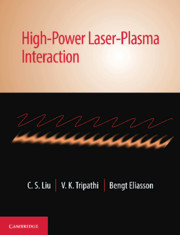Book contents
- Frontmatter
- Dedication
- Contents
- List of Figures
- Preface
- 1 Introduction
- 2 Linear Waves
- 3 Resonance Absorption and Brunel Absorption
- 4 Plasmonics Surface Plasma Waves and Their Coupling to Lasers
- 5 Motion in a Strong Electromagnetic Wave: Ponderomotive Force and Self-Generated Magnetic Field
- 6 Laser Electron Acceleration
- 7 Laser Acceleration of Ions
- 8 Coherent Radiation Emission: Free Electron Laser
- 9 Self-focusing and Filamentation
- 10 Parametric Instabilities
- 11 Parametric Instabilities in Inhomogeneous Plasma
- 12 Nonlinear Schrödinger Equation
- 13 Vlasov and Particle-in-Cell Simulations
- 14 Strong Electromagnetic Field Effects in Plasma
- Index
13 - Vlasov and Particle-in-Cell Simulations
Published online by Cambridge University Press: 26 April 2019
- Frontmatter
- Dedication
- Contents
- List of Figures
- Preface
- 1 Introduction
- 2 Linear Waves
- 3 Resonance Absorption and Brunel Absorption
- 4 Plasmonics Surface Plasma Waves and Their Coupling to Lasers
- 5 Motion in a Strong Electromagnetic Wave: Ponderomotive Force and Self-Generated Magnetic Field
- 6 Laser Electron Acceleration
- 7 Laser Acceleration of Ions
- 8 Coherent Radiation Emission: Free Electron Laser
- 9 Self-focusing and Filamentation
- 10 Parametric Instabilities
- 11 Parametric Instabilities in Inhomogeneous Plasma
- 12 Nonlinear Schrödinger Equation
- 13 Vlasov and Particle-in-Cell Simulations
- 14 Strong Electromagnetic Field Effects in Plasma
- Index
Summary
Introduction
Particle-in-cell (PIC) and Vlasov simulations both solve the Vlasov equation. The Vlasov equation (cf. Chapter 2) governs the evolution of the distribution function of charged particles (electrons, ions) in the six-dimensional phase space, consisting of three velocity (or momentum) dimensions and three position dimensions, plus time. It offers an accurate description of a plasma in the collisionless limit; that is, when the particles are affected by long-range electric and magnetic fields only, and when short-range fields from their nearest neighbors can be neglected.
PIC simulations resolve the distribution function statistically with macro-particles (or super-particles) and follows the solution over trajectories along which the distribution function is constant; the characteristics are given by the equations of motion for the charged particles. This is the Lagrangian description. Many PIC codes have been developed over the years; modern PIC codes include the plasma simulation code (PSC) originally developed by Hartmut Ruhl, the implicit iPIC3D code aimed at connecting kinetic and magnetohydrodynamic time scales, the EPOCH code, partially based on PSC, the VSIM/VORPAL code, the OSIRIS code, and QuickPIC. PIC simulations are very adaptive and efficient for many problems, such as high-energy beam–plasma and laser–plasma interactions. On the other hand, they also have limitations; the numerical noise and slow convergence with increasing number of particles are some issues. There is also the need to resolve the Debye length with particles to avoid artificial numerical heating.
A different strategy is followed in Vlasov simulations using a Eulerian description. Here, the distribution function is treated as a phase fluid resolved on a fixed numerical grid. Vlasov simulations do not have the statistical noise of PIC simulations; they can also more accurately resolve the high-velocity tail of the particle distribution functions. On the other hand, Vlasov simulations in higher dimensions are very memory demanding due to the need to resolve the six-dimensional phase space on a numerical grid. In some cases, the distribution function can also become oscillatory in phase space, leading to sharp gradients and a need to introduce numerical dissipation in velocity space whilst avoiding artificial numerical heating due to the broadening of the distribution in velocity space. Hence, the choice between PIC and Eulerian Vlasov simulations strongly depends on the physical problem at hand.
- Type
- Chapter
- Information
- High-Power Laser-Plasma Interaction , pp. 263 - 274Publisher: Cambridge University PressPrint publication year: 2019

